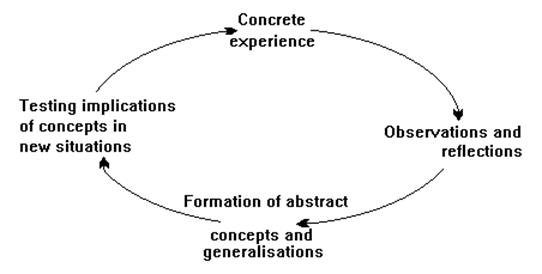PROBLEM-BASED LEARNING workshop
Kenneth Ronkowitz
Home > Presentations
What is PBL?
- Instructional Strategy
- Similar to the Socratic Method
- Used extensively in medical schools
- Howard S. Barrows is a PBL pioneer
What it is not…
- “Alternative to teaching”
- Easy to adopt
- A quick substitute for lecturing
How does it work?
- Relies on small groups working with a facilitator.
- Relies heavily on scenarios to guide the learning process.
- Forces the student to take responsibility for their learning.
Why instructors use it
- Acquisition of an extensive integrated knowledge base.
- Real world examples.
- Move beyond cram & regurgitate model
- Great way to teach people how to acquire large amounts of information in a short period of time for rapidly changing fields.
- It is often the “unplanned” method of instruction in work/project situations.
The PBL Process
- Class needs to be broken into small groups (4-8 people).
- Groups work together extensively
- Each group needs a moderator.
- Guides group through process
- Trains group to work together
- Guide without giving away or hiding the answer
Each group gets a scenario-based problem set.
- Each problem set contains scenarios that build on each other.
- Problems/scenarios are a vehicle for the development of clinical problem solving skills
- The group identifies the following five components:
- The facts that are known
- Facts/questions that need to be asked
- Possible hypothesis
- What needs to be learned
- Where will the group members go to gain the necessary information
Once the 5 categories are addressed:
- Group researches necessary issues
- Returns later to to present their findings
- Receives a new scenario that builds upon the older one
- Group begins the process again with the new scenario
Areas open to debate:
- What to do with the shy student(s)
- What to do with the outgoing student(s)
- Should each group member research every item identified under the “What needs to be learned column”
Requirements
- Students must have/take responsibility for their own learning.
- Scenarios must allow for free inquiry.
- Scenarios must integrate multiple disciplines.
- Group Members must collaborate.
- Group Members must continually share what they learn.
- There must be analysis of what was learned (final reports, exams, etc.).
- Self and Peer assessment.
Kolb’s Experiential Learning Cycle

Sample Scenarios
Fundamentals of Physics II Group Exercise -- Punkin' Chunkin' http://www.punkinchunkin.com/
Sample PBL Scenarios at http://www.udel.edu/inst/
Hands-On Activity - M&M’s Activity
The Instructor’s Role in PBL
- Specify the objectives.
- Monitor groups regularly and intervene only when required.
- Point the way – make adjustments when groups are off task and their direction will not result in significant learning.
- If necessary, ask OPEN-ENDED questions like: What do we need to know more about? What is your evidence?
- Help students REFLECT on their experiences
- Raise issues that need to be considered - YOUR experience, but not your knowledge is critical to share.
- Be prepared to teach mini-lessons on skills along the way – the “teachable moment.”
- Evaluate student achievement and group efforts on a scheduled basis.
- Keep students apprised of their performance (rubrics) and progress in relation to other groups.
- Research suggests that students benefit from immediate feedback from instructors so that misconceptions can be cleared promptly (Norman and Schmidt, 1992).
- In the classroom, teachers should act as meta-cognitive coaches, serving as models, thinking aloud with students and practicing behavior they want their students to use (Stepien and Gallagher, 1993).
For the Instructor
Use scenarios to train students that are non-threatening because they do not require knowledge. It is recommended that training scenarios are not about the course content (though they may be related to the discipline.)
Scenarios should have a completion time of 2-3 class sessions, up 4 weeks.
Some research (Gijselaers and Schmidt, 1992) has shown that there is a point of diminishing returns. After a certain number of hours per week, the amount of teacher-centered time in class detracts from students' self-study time.
The instructor may also need to address the perceived delay in the student performance that often occurs. Research shows that PBL students may not achieve as much, initially with the implementation of PBL (Schmidt, et. al, 1996).
However, PBL students retain more than their traditionally educated counterparts and learn life-long, self-directed learning skills that other students may not.
The beauty of PBL is that students use their prior knowledge when developing ideas and formulating those ideas into hypothesis that can be tested.
The advanced level of a college student will result in a deeper, more complex investigation than would be done by a younger student even if very similar scenarios are used.
Schmidt, Bridges and Barrows strongly suggest that the instructor provide unstructured time in the class in order for students to assemble in their teams, work with resources, contact and meet with faculty members who may be helpful to their project, and accomplish other tasks necessary in the resolution of the problem.

